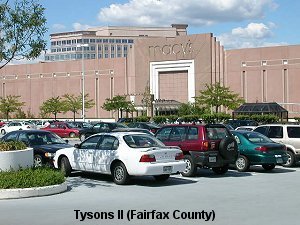Obviously there is no guarantee than any of the speculations below will come true. Still, one
application of your understanding of Virginia geography is to predict the future. If you are presenting a business
plan to a venture capitalist or banker, or talking to a neighborhood group about to lose its local playing field to a
road realignment, or just a voter interested in what candidate to support, it makes sense to project from the present
into the future before making your decision. Your understanding of regional history, economic geography,
transportation patterns, population trends, etc. can be used in making real-world decisions long after you've taken
your last geography test in school...
How Will Northern Virginia Transportation Change?
If the Internet continues to expand its reach, and business strategies like "AOL Anywhere" approach is successful,
think "work anywhere" can be far behind?
Northern Virginia has one of the worst commuting delays of any region in the country. Housing is so spread out
that commuters need to drive just to reach a bus pickup or rail station - and on the other end, after changing buses
or trains at least once, you're still a mile from the office itself.
 Most of the acreage at a shopping center is car habitat, not people-centered. To get around, curvy colonial roads are filled with cars and school buses - and then you have to account for delays from construction, rain and ice, little ol' ladies from Pasadena and other tourists that have no clue where they are going, 8-lane highways that are squeezed onto 6-lane bridges, and of course the accidents.
Most of the acreage at a shopping center is car habitat, not people-centered. To get around, curvy colonial roads are filled with cars and school buses - and then you have to account for delays from construction, rain and ice, little ol' ladies from Pasadena and other tourists that have no clue where they are going, 8-lane highways that are squeezed onto 6-lane bridges, and of course the accidents.
When commuters start to get blasé over everything short of a dynamite
truck overturned at the Springfield interchange, and shout at police for closing
highways to talk gun-wielding suicide candidates into surrendering, you know
the Northern Virginia commute has reached the level of Los Angeles and Atlanta
and Boston and New York driving.
- [Tokyo and Lagos and Mexico City, here we come?]
So if you think about how this will change in the future, listen to the political candidates in any election (and for
almost any office...) promise improved roads and more funding for public transit. Then think "more road
construction" and "higher taxes to pay for public transportation."
At some point, think the public attitudes might shift - even the attitude about living in the District and having a
reverse commute? If you watch the traffic on westbound I-66 at 7:00am, or eastbound at 4:30pm, you might
assume that some people have already adjusted their perspective.
A groundswell of people moving into the District may not happen soon. More likely, the "work at home"
revolution will spread more rapidly. There are already 17 Federal government telecommuting centers around
Washington now, designed both to reduce traffic and to retain/attract high-value employees. Employees drive to
these facilities in part because they lack computer equipment and high-speed Internet access at their home, and in
part because managers want some assurance that their staff are actually working during scheduled hours.
60% of Washington-area households have at least dial-up access to the Internet now, in contrast to the 25% rate
nationally. Though government bureaucracies may be slow to adapt to the changed work environment, high-tech
employers are likely to support work-at-home arrangements, especially where a company is creating productivity-
enhancing software.
So in the next 20 years, a commute in Northern Virginia may consist of padding in slippers to the dedicated room
over the garage or in the basement, and require no use of the automobile.
Links
What Comes After Sprawl?
Evolution of Northern Virginia
Virginia Places
 Most of the acreage at a shopping center is car habitat, not people-centered. To get around, curvy colonial roads are filled with cars and school buses - and then you have to account for delays from construction, rain and ice, little ol' ladies from Pasadena and other tourists that have no clue where they are going, 8-lane highways that are squeezed onto 6-lane bridges, and of course the accidents.
Most of the acreage at a shopping center is car habitat, not people-centered. To get around, curvy colonial roads are filled with cars and school buses - and then you have to account for delays from construction, rain and ice, little ol' ladies from Pasadena and other tourists that have no clue where they are going, 8-lane highways that are squeezed onto 6-lane bridges, and of course the accidents.